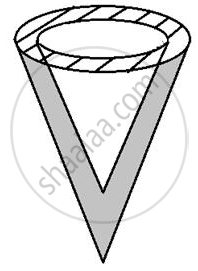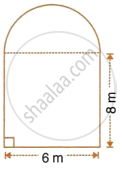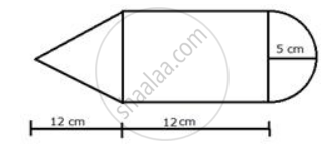Advertisements
Advertisements
प्रश्न
The ratio of the base area and the curved surface of a conical tent is 40: 41. If the height is 18 m, Find the air capacity of the tent in terms of n.
उत्तर
Given: `"base area"/"curved surface" = 40/41`
⇒ `(πr^2)/(πrsqrt(h^2 + r^2)) = 40/41` ...( Where h is the height and r is the radius of conical tent)
⇒ `(r)/(sqrt(18^2 + r^2)) = 40/41` ....( ∵ h = 18 m)
⇒ r = 80 m
∴ Air capacity = `1/3 π (80)^2 xx 18`
Air capacity = 38,400 π cu m.
APPEARS IN
संबंधित प्रश्न
Diameter of the base of a cone is 10.5 cm and its slant height is 10 cm. Find its curved surface area.
`["Assume "pi=22/7]`
A joker’s cap is in the form of right circular cone of base radius 7 cm and height 24 cm. Find the area of the sheet required to make 10 such caps.
`["Assume "pi=22/7]`
The radius of a cone is 5 cm and vertical height is 12 cm. Find the area of the curved surface.
Find the total surface area of a cone, if its slant height is 21 m and diameter of its base is 24 m.
What length of tarpaulin 3 m wide will be required to make a conical tent of height 8 m and base radius 6 m? Assume that the extra length of material will be required for stitching margins and wastage in cutting is approximately 20 cm (Use it 𝜋 = 3.14)
Find the volume of a right circular cone with:
radius 3.5 cm, height 12 cm
Find the volume of a right circular cone with:
height 21 cm and slant height 28 cm.
A cylinder and a cone have equal radii of their bases and equal heights. Show that their volumes are in the ratio 3:1.
Find the volume of a cone whose slant height is 17 cm and radius of base is 8 cm.
There are two cones. The curved surface area of one is twice that of the other. The slant height of the latter is twice that of the former. Find the ratio of their radii.
The internal and external diameter of a hollow hemispherical vessel are 21 cm and 28 cm respectively. Find :
- internal curved surface area,
- external curved surface area,
- total surface area,
- volume of material of the vessel.
A solid metallic cone, with radius 6 cm and height 10 cm, is made of some heavy metal A. In order to reduce its weight, a conical hole is made in the cone as shown and it is completely filled with a lighter metal B. The conical hole has a diameter of 6 cm and depth 4 cm. Calculate the ratio of the volume of metal A to the volume of the metal B in the solid.

A buoy is made in the form of hemisphere surmounted by a right cone whose circular base coincides with the plane surface of hemisphere. The radius of the base of the cone is 3.5 metres and its volume is two-third of the hemisphere. Calculate the height of the cone and the surface area of the buoy, correct to two places of decimal.
The cross-section of a railway tunnel is a rectangle 6 m broad and 8 m high surmounted by a semi-circle as shown in the figure. The tunnel is 35 m long. Find the cost of plastering the internal surface of the tunnel (excluding the floor) at the rate of Rs. 2.25 per m2.

A solid, consisting of a right circular cone standing one a hemisphere, is placed upright in a right circular cylinder, full of water, and touches the bottom. Find the volume of water left in the cylinder, having given that the radius of the cylinder is 3 cm and its height is 6 cm; the radius of
the hemisphere is 2 cm and the height of cone is 4 cm. Give your answer to the nearest cubic centimeter.
A sphere and a cone have the same radii. If their volumes are also equal, prove that the height of the cone is twice its radius.
The total surface area of a right circular cone of slant height 13 cm is 90π cm2. Calculate: its volume in cm3. Take π = 3.14
The given figure shows the cross-section of a cone, a cylinder and a hemisphere all with the same diameter 10 cm and the other dimensions are as shown. Calculate: the density of the material if its total weight is 1.7 kg

The curved surface area of a right circular cone of height 15 cm and base diameter 16 cm is
